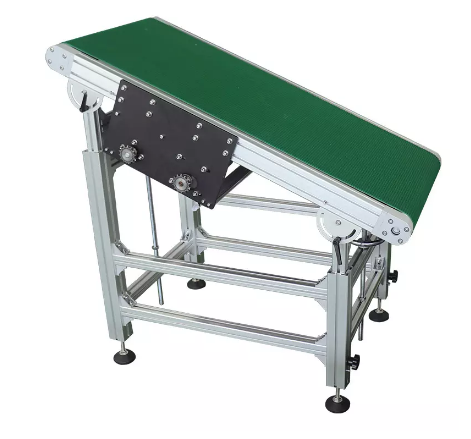
Maintaining your automatic aluminum conveyor system is crucial for smooth operations. Without regular upkeep, your equipment could suffer from costly breakdowns.
In this post, you’ll learn essential tips for daily inspections, lubrication, and periodic maintenance to ensure optimal performance and extend the system's lifespan.
Why Maintenance is Crucial for Your Automatic Aluminum Conveyor System
Preventative maintenance is key to keeping your automatic aluminum conveyor system running smoothly. Regular upkeep not only helps identify potential issues early but also prevents costly damage. When components like the belt or motor wear down or misalign, they can cause disruptions in the system.
Unchecked wear leads to system failures that can halt operations and result in expensive repairs. A well-maintained conveyor reduces downtime, keeps the system working efficiently, and lowers repair costs. Proper care ensures everything works at its best, making your operations more reliable and cost-effective.
Here are some key reasons why regular maintenance matters:
Prevents Equipment Failures: Routine checks detect early signs of wear or damage.
Reduces Downtime: Timely maintenance helps avoid unexpected breakdowns.
Improves Safety: Ensures all safety features are functioning correctly.
Boosts Efficiency: A well-maintained system runs at peak performance.
Daily Maintenance Tips for Your Conveyor System
Daily maintenance is crucial to prevent small issues from becoming larger, more costly problems. A few minutes of attention each day can save hours of downtime and expensive repairs. Here are some key tasks to include in your daily routine:
Visual Inspection
Start by visually inspecting your conveyor system. Look for signs of wear or damage such as cracks in the belt, misaligned rollers, or any unusual movements. Catching these issues early can prevent more significant damage.
Cleaning and Removing Debris
Keep your conveyor system clean and free from dust, debris, and material build-up. Regular cleaning reduces friction and wear. Focus on cleaning the belt, rollers, and surrounding areas to ensure smooth operation.
Checking for Slippage
Ensure the belt is properly aligned and not slipping. Belt slippage can cause inefficient operation and lead to potential system failure. If you notice slippage, adjust the tension and check the tracking to ensure it runs smoothly.
Listening for Abnormalities
Pay attention to any unusual sounds while the system is running. Grinding, slapping, or squeaking noises could indicate a mechanical issue. These sounds often signal problems that need immediate attention to prevent further damage.
Weekly Maintenance for Your Conveyor System
Weekly maintenance goes beyond basic checks and involves more detailed tasks to ensure everything runs smoothly. Here are key areas to focus on:
Lubricating Moving Parts
Apply the right lubricant to bearings, pulleys, and other moving parts based on the manufacturer’s recommendations. Proper lubrication reduces friction and prevents parts from wearing out too quickly. Don’t forget to check the lubricant levels regularly.
Inspecting Belts and Rollers
Check the belts for signs of wear, fraying, or misalignment. Damaged belts can lead to poor performance and system breakdowns. Also, inspect the rollers for blockages or damage. Keeping the rollers clean and aligned ensures smooth movement.
Tightening Fasteners
Loose fasteners can cause instability, vibrations, and unnecessary stress on the system. Regularly tighten all bolts, nuts, and other fasteners to prevent vibrations and maintain the system's stability. This simple step can prevent much larger issues.
Deep Cleaning
Clean the entire conveyor system thoroughly each week. This includes removing dirt, debris, and material build-up from the belt, rollers, and surrounding components. Keeping everything clean reduces friction and prevents damage to the system.
Periodic Maintenance for Long-Term Conveyor Health
Periodic maintenance, performed monthly or quarterly, involves more detailed checks to keep your conveyor system healthy. These in-depth tasks focus on inspecting and replacing worn-out components to prevent unexpected failures.
In-depth Inspections
Every few months, conduct thorough inspections of your conveyor system. Check for any signs of misalignment, excessive wear, or damage to critical components such as the belts, rollers, and pulleys. Early detection of issues helps you address them before they cause major disruptions.
Replacing Worn Parts
Over time, parts like belts, rollers, and bearings wear out. Replacing them before they fail ensures the system continues to function smoothly and prevents more expensive repairs down the line. Keep track of part wear and replace components as needed.
Safety Feature Check
Safety features are critical to the smooth operation of your conveyor system. Test all safety mechanisms, such as emergency stops, sensors, and guards, to ensure they are working properly. A failure in any of these features can pose a significant risk.
Lubrication Analysis
For larger systems, consider conducting a lubrication analysis. This helps monitor the condition of the lubricant, ensuring it's effective in reducing friction. It can also alert you to potential issues with bearings, gearboxes, or other moving parts.
General Tips for Conveyor System Longevity
To keep your automatic aluminum conveyor system and assembly line conveyor running smoothly for years, follow these general tips for longevity. These practices will help prevent major issues and ensure your system continues operating efficiently.
Develop a Maintenance Schedule
Create a maintenance schedule tailored to your system's needs. Refer to the manufacturer’s recommendations for guidelines on inspection frequency and required tasks. Consider factors like the conveyor's workload, speed, and environmental conditions when planning maintenance intervals.
Address Issues Promptly
Even small issues can turn into bigger problems if ignored. It’s important to address minor issues early before they escalate into expensive repairs. Regularly check for misalignments, wear, or unusual noises and fix them as soon as they appear. Proactively managing these problems helps avoid costly downtime.
Training Your Team
Ensure your maintenance team is properly trained in operating and maintaining the conveyor system. A knowledgeable team will identify potential issues early and act quickly to fix them. Investing in training improves the system's overall reliability and reduces the likelihood of mishaps.
Conclusion
Maintaining your automatic aluminum conveyor system is key to long-term efficiency. Regular maintenance, prompt issue resolution, and proper team training help keep it running smoothly. Regular inspections, cleaning, lubrication, and replacing worn parts ensure optimal performance and extend the system’s lifespan.
FAQs
Q1: Why is regular maintenance important for my automatic aluminum conveyor system?
A1: Regular maintenance prevents breakdowns, extends the system's lifespan, and ensures it operates efficiently. It helps catch minor issues early, saving you time and money in the long run.
Q2: How often should I perform maintenance on my conveyor system?
A2: It depends on the system's usage and the manufacturer’s recommendations. Typically, daily, weekly, and periodic maintenance tasks should be scheduled to keep the system running smoothly.
Q3: What are the main tasks in daily maintenance for a conveyor system?
A3: Daily tasks include visual inspections, cleaning debris, checking for belt slippage, and listening for unusual noises. These small tasks help prevent larger issues from developing.
Q4: How can I ensure my conveyor system stays safe during operation?
A4: Regularly check safety features such as emergency stops and sensors. Ensuring these are functioning properly reduces the risk of accidents and system failures.
Q5: What should I do if I notice a small issue with my conveyor system?
A5: Address minor issues immediately to prevent them from escalating into larger problems. Regular checks and quick fixes help minimize downtime and repair costs.









